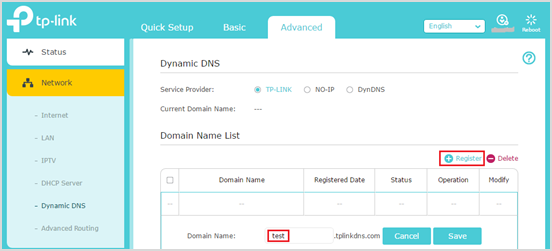Cómo configurar el DDNS de TP-LINK en el router inalámbrico de TP-Link (nuevo logotipo)
Nota:
1. Estas preguntas frecuentes son adecuadas para enrutadores inalámbricos TP-Link con funciones en la nube, como Archer C8 V3, Archer C9 V3 / V4, etc.
2. Actualmente, la mayoría de los modelos aplicables solo admiten la función de actualización en línea, y se agregarán otras funciones en la nube en el firmware futuro.
3. En cuanto a Archer C5400 V1, solo la versión de la UE es compatible con los servicios en la nube. Verifique la versión de hardware en la etiqueta en la parte posterior del enrutador.
La mayoría de los ISP (proveedores de servicios de Internet) asignan una dirección IP dinámica al router y usted puede utilizar esta dirección IP para acceder a su router de forma remota. Sin embargo, la dirección IP puede cambiar en cualquier momento y no se sabe cuándo cambia. En este caso, es posible que necesite la función DDNS (Servidor de nombres de dominio dinámico) en el enrutador para permitirle a usted y a sus amigos acceder a su enrutador y servidores locales (FTP, HTTP, etc.) utilizando un nombre de dominio, sin necesidad de verificar y recordar las direcciones IP dinámicas.
TP-LINK es uno de los proveedores de servicios DDNS en los enrutadores inalámbricos TP-Link con funciones en la nube.
Aquí, siga los pasos a continuación para configurar su DDNS de TP-LINK.
Paso 1
Registre y vincule su cuenta en la nube de TP-Link al enrutador inalámbrico TP-Link. Para saber cómo hacerlo, haga clic aquí.
Paso 2
Vaya a Avanzar > red > DNS dinámico. Seleccione TP-LINK como proveedor de servicios DDNS. Haga clic en Registrar, introduzca un nombre de host para crear su propio nombre de dominio, por ejemplo, test.tplinkdns.com. A continuación, sólo tienes que hacer clic en Guardar y el nombre de dominio se vinculará automáticamente a tu router.


Notas:
- Asegúrese de tener Internet cuando registre un nombre de dominio TP-LINK.
- Si no registra un nombre de dominio TP-LINK, significa que su nombre de dominio ha sido registrado por otros. Intente cambiar otro nombre de host.
- Su nombre de dominio estará vinculado a la dirección IP pública externa de su red. Por lo tanto, no se preocupe si el ISP asigna una dirección IP WAN privada (como 192.168.1.x) al enrutador.
- Si desea cambiar el nombre de dominio, simplemente haga clic en Desvincular y Eliminar su nombre de dominio actual. A continuación, pulse Registrar para vincular uno nuevo.
Conozca más detalles de cada función y configuración, vaya al Centro de descargas para descargar el manual de su producto.
¿Es útil este artículo?
Tus comentarios nos ayudan a mejorar esta web.


